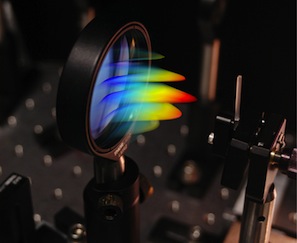PHYS721/821 - Graduate Quantum Mechanics II

General Information
This is the second semester of the Graduate Quantum Mechanics sequence
at ODU. See here for the first
semester.
Instructor:
Dr.
Sebastian E. Kuhn
Time and Location:
Tuesdays and Thursdays, 5:45 - 7:00 p.m., Room 202 OCNPS
Recitation Sessions by mutual agreement: Fridays 3-4 p.m.
Course Material:
Recommended Books (sorted by match with lecture content)
- R. Shankar: "Principles of Quantum Mechanics", 2nd Ed. Springer
1994. I will follow the general approach and much of the material of
this book, while leaving some of the more advanced topics to the 2nd
semester (PHYS821). If at all possible, buy this book - we will use it
most extensively!
- G. Arfken: "Mathematical Methods for Physicists" - the best
collection of all the math needed by most Physicists
- A. Messiah: "Quantum Mechanics" (2-volume edition bound as 1
book), Dover Publication 1999. A comprehensive collection of material,
cheap on Amazon etc.
- D.
Griffiths: "Introduction to Quantum Mechanics", 2nd edition
(Pearson 2005) and S. Gasiorowicz: "Quantum Physics" 3rd edition (Wiley
2003). Two lower-level books with more basic explanations and
applications to help you "make sense of it all". Useful if you already
have them, but don't buy just for this class (you can always go to the
library).
- C. Cohen-Tannoudji, B. Diu, F. LaloŽ: "Quantum Mechanics"
Volumes 1 and 2, Wiley. The most comprehensive tome, but somewhat hard
to read. For people who think this class is too easy! ;-)
- JJ. Sakurai: "Modern Quantum Mechanics" Revised Edition, Addison
Wesley 1994. Relatively compact but intense.
Recommended Lecture Notes
Dr. W. van Orden's Lecture Notes on Quantum
Mechanics (priceless!)
Syllabus and Schedule
Preliminary
schedule of topics, linked to page numbers in R. Shankar's
book
Syllabus
Collection
of useful formulae and relationships
News and Announcements
I have posted (under Useful Links) a
replica of the page with Clebsch-Gordan coefficients for your viewing
pleasure.
Make sure you attend all colloquia - it's part of your "course load"
(and, more importantly, your education as a Physicist).
Lecture Notes
- 1st lecture (Statistics and ensembles of particles)
- 2nd lecture (Density matrix)
- 3rd lecture (Multi-particle states)
- 4th lecture (Entanglement)
- 5th lecture (Bosons and Fermions)
- 6th lecture (Bosons and Fermions)
- 7th lecture (Bosons and Fermions)
- 8th lecture (Tensor Operators, Wigner-Eckart Theorem)
- 9th lecture (Classical Limit: Particle-Wave-Fluid)
- 10th lecture (Classical Limit: Wave-Fluid and Wigner Function)
- 11th lecture (Classical Limit: WKB method)
- 12th lecture (Path integral formalism)
- 13th lecture (Path integral formalism + Variational Method)
- 14h lecture (Variational Method)
- 15th lecture (Time-independent Perturbation Theory)
- 16th lecture (Time-independent Perturbation Theory II); see also our Recitation Session of March 22
- 17th lecture (Time-independent Perturbation Theory III)
- 18th lecture (Time-dependent Perturbation Theory I) (really covers 1 1/2 lectures); supplemental material (higher order Time-dep. PT)
- 19th lecture (Time-dependent Perturbation Theory II) (really covers 1 1/2 lectures)
- 20th lecture (Time-dependent Perturbation Theory III)
- 21st lecture (Scattering Theory I - 1D)
- 22nd lecture (Scattering Theory II - Phase Shifts); see also my 2-page overview of scattering theory in general
- 23nd lecture (Scattering Theory III - Born Approximation)
Tying it all together: Relativistic elastic scattering (Recitation Friday 4/27)
Homework
Useful Links
The following PDF File contains all
Clebsch-Gordan coefficients you'll ever need (and even things like Ylm's
and rotational matrices dmm'!). Note that what's given is
<j1j2m1m2|JM>, where j1
x j2 is indicated at the top left corner of every
"mini-table", J and M are on top of each other as column labels and m1
and m2
are next to each other as row labels. Be careful to put a square root
over each of the fractions, and of keeping track of minus signs: <j1j2
m1m2|JM> = <JM|j1j2
m1m2>, but if you interchange j1
and j2 (as you must if your j2 is
larger than your j1), you get a total minus sign if J - j1
- j2 is odd! Finally, here is the Wigner-Eckard Theorem:
<a,j',m'|Tkq|a,j,m> = <a,j'||Tkq||a,j><j'm'|kj
qm>.
I made a little page with pictures of
spherical Harmonics and spherical Bessel functions (partially stolen
from http://whitedwarf.org/education/vis/
)
Some more "quantum links" of potential interest:
A collection of QM-related tutorials, animations, notebooks...: http://www.thequantumexchange.org/
A special edition of Physics World - a lot about QM in the middle section.
Is Heisenberg's uncertainty principle under siege? Not really...
A somewhat unusual approach to teaching quantum mechanism - [viewer discretion advised]
http://physicsworld.com/cws/article/news/2013/feb/13/the-quantum-coin-toss
http://www.newscientist.com/blogs/shortsharpscience/2013/01/quantum-smell-theory-causes-ne.html
The Pauli principle "reloaded"
A light-hearted look at what "expert quantum physicists" think about the meaning of it all: http://arxiv.org/pdf/1301.1069v1.pdf - here is a simplified writeup.
Two entangled particles not exciting enough? How about eight? http://www.livescience.com/18504-quantum-entanglement-photons.html
Physics World's list of the 10 greatest discoveries of 2011 - at least
4 are directly related to Quantum Mechanics:
http://physicsworld.com/cws/article/news/48126
Take a look at
http://www.newscientist.com/article/mg21328505.100-asteroid-orbits-modelled-in-a-single-atom.html
- relating to the "molecular cloud picture" of QM wave functions
(and the classical limit)...
A new take on particle-wave duality
Here is a link
to the classical paper by Aharonov and Bohm on the "ghostly" effect of
the vector potential on the wave function of an electron.
...and here
is a thoroughly amusing (unintentionally so) example of "quantum
quackery". Warning: Don't sign up or take anything on this site
seriously!
On the other hand, this discussion is more serious and challenging: http://www.nature.com/news/2011/110602/full/news.2011.344.html
